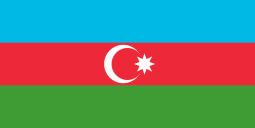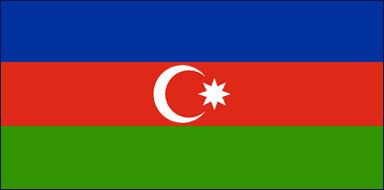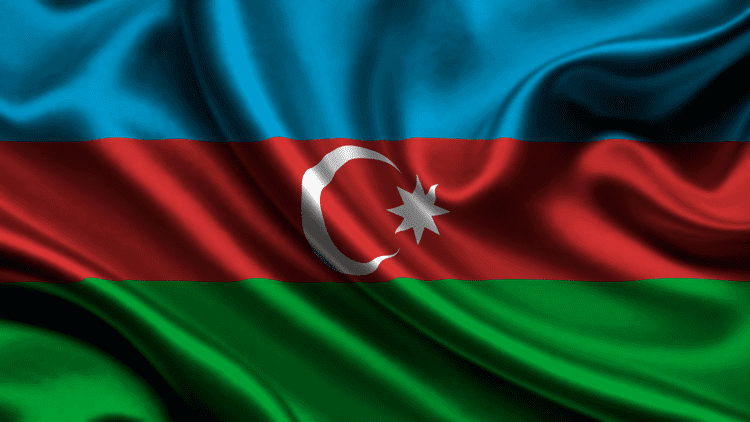Proportion 1:2 | Adopted on 9 November 1918 | |
 | ||
Names Azərbaycan bayrağı, Üçrəngli bayraq (The tricolour flag) | ||
Flag of azerbaijan
The flag of Azerbaijan (Azerbaijani: Azərbaycan bayrağı) is a horizontal tricolour featuring three equally sized fesses of blue, red, and green, with a white crescent and an eight-pointed star in the center. The tricolour replaced an earlier design used by the Azerbaijan SSR. The blue symbolizes Azerbaijan's Turkic heritage, the red stands for progress, and the green represents Islam. The official colors and size were adopted on February 5, 1991. This flag was used from November 9, 1918 to 1920, when Azerbaijan was independent, and it was revived with slight variations on February 5, 1991. The nickname for the flag is Üçrəngli Bayraq, which means The Tricolour Flag.
Contents
- Flag of azerbaijan
- Design
- Symbolism
- Pre Soviet
- Transcaucasian SFSR
- Azerbaijan SSR
- Regaining independence
- Display and use
- Use in funerals
- Influence and derivatives
- References

The flag is referred to in the Constitution and mentioned two times in the national anthem. On land, the flag is used as the civil, state and war flag; at sea, it is used as the civil, state, and naval ensign, as well as the naval jack. The flag also has official status in the Nakhchivan Autonomous Republic. A presidential decree declared November 9, the date when in 1918 this flag was adopted as the national flag of Azerbaijan Democratic Republic, as the national Flag Day.

Flag of azerbaijan
Design

The national flag of Azerbaijan consists of three horizontal stripes of equal width, from top to bottom: light blue, red, and green. In the center are a white crescent and eight-pointed star. The basic description of the flag, along with the ratio, can be found in the Constitution of Azerbaijan, which was adopted November 12, 1995:

State flag of the Azerbaijan Republic consists of three horizontal stripes of same width. Upper stripe is blue, middle stripe is red, and the lower one is green; in the middle of red stripe on both sides of the flag white crescent with eight-pointed star are depicted. Width of the flag constitutes half of its length.
Further specifications of the national flag were detailed in the Presidential Decree "On the National Flag of the Republic of Azerbaijan" issued on February 5, 1991. The ratio was kept at 1:2, which was used in the Soviet era. Each stripe is one-third of the total height of the flag and extends the full length. The star and crescent were placed in a box that has a ratio of 3:4; the crescent is shifted one-sixtieth from the center. The outside diameter of both the crescent and the red inside circle intersects with the diameter of the star. The diameter of the star is one-sixth the height of the flag; the inscribed circle in this star is one-twelfth the height of the flag. The flag is also described in the technical specification "AZS 001-2006. Azərbaycan Respublikasının Dövlət Bayrağı. Texniki şərtlər." published by the State Committee on Standardization, Metrology and Patents of the Republic of Azerbaijan in 2006.
The colors of the national flag are green, red, sky blue, and white. Exact specifications for its colors were issued in the 2004 decree "On the Rules of the National Flag of the Republic of Azerbaijan". The colors, later updated in 2013, specified in Pantone, are as follows:
Symbolism
The sky blue symbolizes Turkic Multinationalism, the red is for the progress to establish a modern state and the development of democracy, and green shows the nation's relation to the Muslim world. In the middle of the flag, and appearing on both front and back, are a white crescent and an eight-pointed star.
The first President of the Azerbaijani National Council Mammed Amin Rasulzade noted in his speech, at the parliament's session of the Azerbaijan Democratic Republic, that the colors relate to Turkic freedom, modernity, and Islamic culture. The composer of the anthem of Azerbaijan Uzeyir Hajibeyov includes in the song references to the meaning of the flag: blue for Azerbaijan's multinationalism, red for progress and culture, and green for Islam.
According to historian Nasib Nasibli, Ali bey Huseynzade, one of the ideologists of Azerbaijan's independence, developed the combination based on colors used in 1895.
While the crescent and star are typically seen as markers of Islam, some historians and researchers disagree about why an eight-pointed star is used on the flag of Azerbaijan. Fatali Khan Khoyski points to the eight letters in the word "Azerbaijan" as written in Arabic. The eight points of the star are also thought to stand for the eight Turkic peoples of Azerbaijan. The problem is there are only seven Turkic peoples: Azeris, Ottomans, Jagatais, Tatars, Kipchaks, Selijuks, and Turkomans. It's possible the Kipchaks actually reflect two peoples, the Kazakhs and Kyrgyz, which would make eight. The classification of Turkic peoples pre-Soviet era was different from what it is today.
Pre-Soviet
In 1828, after the last Russo-Persian War, several Khanates of the Caucasus were annexed to the Russian Empire . When the Russian Empire collapsed, Russian Azerbaijan declared its independence and joined the short-lived Transcaucasian Democratic Federative Republic, together with Georgia and Armenia. This unified state hardly lasted a year and was soon dissolved. Since the Republic was short-lived, it did not use any flags or symbols. Nevertheless, some historians consider a horizontal gold, black, and red tricolor, similar to that of the German flag but arranged differently, to have been flag of Transcaucasia. The federation was dissolved on May 26, 1918, when Georgia declared its independence as the Democratic Republic of Georgia. Both Armenia and Azerbaijan declared their independence two days later, on May 28, 1918, as the Democratic Republic of Armenia (DRA) and the Azerbaijan Democratic Republic, respectively.
After gaining independence, the blue-red-green tricolour was adopted by the government of the Democratic Republic of Azerbaijan on November 9, 1918.
Azerbaijan was the first modern democratic state in the Muslim world. The Azerbaijan Democratic Republic lasted only 23 months until the Bolshevik 11th Soviet Red Army invaded it, establishing the Azerbaijan SSR on April 28, 1920. Although the bulk of the newly formed Azerbaijani army was engaged in putting down an Armenian revolt that had just broken out in Karabakh, Azeris did not surrender their brief independence of 1918–20 quickly or easily. As many as 20,000 Azerbaijani soldiers died resisting what was effectively a Russian reconquest.
Transcaucasian SFSR
On March 12, 1922, the Azerbaijani SSR united with the Georgian SSR and the Armenian SSR under the Transcaucasian SFSR. On December 30, 1922 the Transcaucasian SFSR became one of the four Soviet republics that united to form the USSR. The flag of the republic had a hammer and sickle inserted into a star with initials ЗСФСР written in Russian sans-serif script. These letters stand for Закавказская Советская Федеративная Социалистическая Республика. In 1936, the TSFSR was broken up into its three constituent regions, which were named the Azerbaijani SSR, the Georgian SSR, and the Armenian SSR.
Azerbaijan SSR
During the Soviet rule, Azerbaijan SSR had eight different flags. Most of the flags only had slight differences. The adaptations were the result of the disastrous early years of the Soviet Union in the Caucasus. The first unofficial Soviet Azerbaijani flag was used when Russians conquered Baku on April 28, 1920.
The first official flag was adopted in the first constitution, under Article 104, of the Azerbaijan SSR on May 19, 1921. During the time the state language of Azerbaijan SSR was the Azerbaijani Turkic, the alphabet was based on the Arabic script. Therefore, the words A.S.R. were written in Arabic. The eighth and final flag of Soviet Azerbaijan was issued on October 7, 1952. The design was similar to that of the Soviet national flag with a horizontal blue band added on the bottom taking up one quarter of the height of the flag. Definition was as follows:
The national flag of Azerbaijan Soviet Socialist Republic is a panel consisting of two horizontal bands of color: the upper red part of three quarters of the width and the bottom is blue, nearly one quarter the width of the flag with the image on the top left corner of the red band, at the flagpole and gold hammer and sickle, and above them a red five-pointed star framed by gold fringe. The ratio of width to length is 1:2.
Regaining independence
During the Soviet period, Jahid Hilaloglu raised the tricolor over Baku's Maiden Tower in 1956 showing his defiance towards the system. Hilaloglu was ultimately sentenced to four years of imprisonment and his supporter Chingiz Abdullayev was institutionalized. On May 28, 1952 during the Republic Day celebrations in Germany, Mammed Amin Rasulzade raised the tricolor and asked for anyone who can be entrusted to take the flag back to Azerbaijan. Gulmirza Bagirov ultimately brought it to Azerbaijan in secret in the 1970s; this flag was hung over his house in Maştağa on January 20, 1990.
During the late 1980s, unrest in Soviet Azerbaijan, the tricolor Azerbaijan Democratic Republic flag was used in demonstrations calling for independence. On November 17, 1990 on the first session of the Supreme Assembly of the Nakhichevan Autonomous Republic, the 1918 Azerbaijani flag was adopted as the national flag of the autonomous state. This flag was later adopted when the decree, "On change the name and national flag of Azerbaijan SSR", was issued on November 29, 1990. The decree was ratified on February 5, 1991 by the National Assembly of the Republic. The first constitution since independence was adopted on November 12, 1995 after a national vote; one of the articles which described the three-color flag of the republic.
On November 17, 2007, the Azerbaijani President issued a decree "On creation of the National Flag Square" in Baku. The square has a flag pole with a mass of 220 tons and a height of 162 meters. The flag that is flown on this pole has an area of 2,450 square meters; the size of the flag itself is 35 meters wide and 70 meters long and weighs 350 kilograms. A museum dedicated to the national flag was also built at this flagpole. On September 1, 2010 the flag was officially raised to open the museum; subsequently this flag pole became the world's tallest unsupported flagpole, until being overtaken by the 165 meter Dushanbe Flagpole, Tajikistan. In 2009, November 9 was officially declared the National Flag Day. This day is set aside to respect the flag, its history (the Azerbaijan Democratic Republic first adopted the current tricolour on November 9, 1918) and its symbolism.
Display and use
According to Law no. 683 of the Republic of Azerbaijan, dated June 8, 2004 (as amended on September 1, 2005), the national flag must be raised by the following:
The national flag must also be raised over the buildings, military courts and headquarters of military units and naval vessels of the Armed Forces of the Republic of Azerbaijan in the following cases:
Use in funerals
Traditionally, the flag of the Azerbaijan plays a role in military funerals, and occasionally in funerals of other civil servants (such as law enforcement officers, fire fighters, and Azerbaijani presidents).
Influence and derivatives
The expression by Mammed Amin Rasulzade (Azerbaijani: "Bir kərə yüksələn bayraq, bir daha enməz!"; "The flag once raised will never fall!") was the rallying cry of Azerbaijani independence in early 20th century. In 1919, Jafar Jabbarli wrote "To Azerbaijani flag" poem in dedication to the state symbols of Azerbaijan.
The national flag is also mentioned in the national anthem of Azerbaijan, "March of Azerbaijan" in the fifth and fifteenth sentences. The unofficial English translations of the sentences come out to "With three color banner live happily!" and "To hold high your honored flag."
